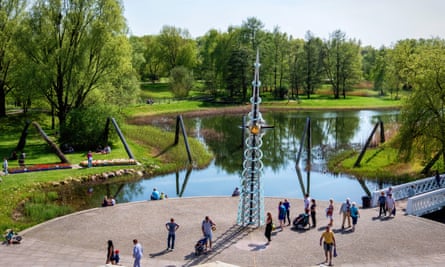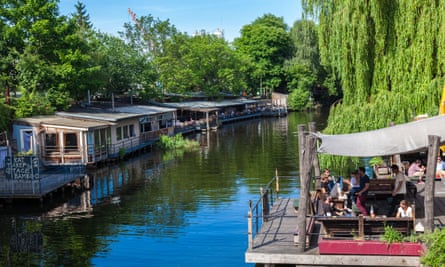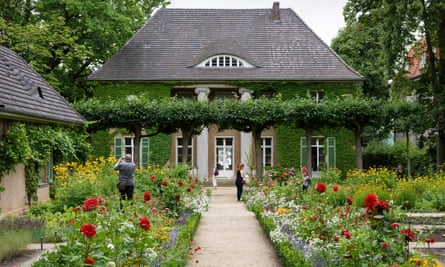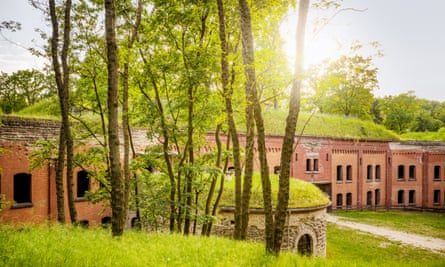“A cable car? Here in Berlin?” The man cooking my burger at Piri’s – a self-proclaimed dive bar diner in Neukölln, an inner-city neighbourhood in the south-east of the city – is sceptical. “Yeah,” says his Kiwi colleague. “My parents did it. There’s a garden or something.”
Both cooks have lived here for upwards of 10 years. They refer to Neukölln, affectionately, as “the ghetto”, seemingly oblivious to the presence of an 18th-century castle, Shloss Britz, and the 220 lush acres of Britzer Garten in the immediate vicinity – let alone the cable car, in the north-eastern district of Marzahn, a 45-minute train ride away.

A new initiative – Ab ins B! (Off to the B!) – spearheaded by Jana Friedrich, head of the tourism board for Spandau, a region in the city’s west, seeks to rectify this lack of awareness. While Berlin’s A-zone – encircled by the Ring created by the S-Bahn, and where “bucketlist” sights such as Brandenburg Gate, the Reichstag, Museum Island, Checkpoint Charlie and the Holocaust Memorial are located – grapples with problems of over-tourism, it comprises only three of Berlin’s 12 districts. Farther afield, in the B-zone (akin to London’s zone 2) lie nine others, including Treptow-Köpenick, Tempelhof-Schöneberg, Steglitz-Zehlendorf, Marzahn-Hellersdorf and, of course Spandau – all ripe for discovery.
“The idea behind ‘Ab ins B!’ was to promote what the areas outside the centre have to offer,” says Friedrich. “We tested the idea on a local level, initially, but it was so successful that we’re now looking at ways to heighten awareness of these lesser-visited areas for overseas tourists. For now, the Ab ins B! section of the Visit Berlin site (also available in English) contains detailed information about each of the B-zone neighbourhoods and their attractions.”
A metro map, covering both the S and U-Bahns, is an invaluable tool for plotting your exploration of Berlin’s outer reaches, and I pick up one of these, along with a Berlin Welcome Card (available online or at tourist boards). Not only does the card grant unlimited travel throughout zones A and B, but its accompanying guidebook offers off-the-beaten track suggestions and grants discounts to certain attractions, including Berlin’s only indoor surf arena in the B-zone’s Lichtenberg district.
I have never thought of Berlin as verdant and manicured. I’ve always considered the city to wear the scars of its divided past whether it wants to or not, and have seen this as integral to its deserved reputation as a vibrant cultural hub, where creativity and hedonism abound, rising from a dark history.

For those with an interest in the past there is still plenty to discover in the B-zone. At Wannsee, around a 40-minute journey from Alexanderplatz, I visit Haus der Wannsee-Konferenz where, in 1942, representatives from the SS and the Nazi party convened to discuss their “final solution” to the existence of a Jewish population. Around Schöneberg’s Bayerischer Platz, a 12-minute train journey from Hermannplatz, an installation of 80 German-language placards unapologetically sets out the legislation with which the Jewish people were systematically isolated in the lead-up to the Holocaust. In the south-eastern Treptow-Köpenick district, I visit the Nazi Forced Labour Documentation Centre, housed within a former camp where photos of “workers” loom large alongside fragments of letters and diary entries.
For more cultural fodder there’s plenty beyond central Berlin’s Museum Island, too, I discover, not least Liebermann Villa, the idyllic former summer home of painter Max Liebermann. A five-minute lakeside walk from Haus der Wannsee-Konferenz, it houses a permanent exhibition of the artist’s works, many inspired by the glorious gardens that surround the house. In Spandau, in the west, I visit the Georg Kolbe Museum, where the sculptor’s works are displayed alongside an ever-changing programme of classical modernism; in Lichtenberg, immediately east of the Ring, I experience the trippiness of Dark Matter, a series of light and sound installations, housed in the disorienting darkness of a former factory.

Venturing out each day from Abion, my Spree-side hotel in Bellevue, I decide that the B-zone is just as fascinating as the centre, with the added allure of mitigating greenness. Leaving the grey chill of the Forced Labour Documentation Centre, I walk, in spring sunshine, to Wuhlheide Park, which is so vast that it contains the whole of Berlin – in miniature in the Modellpark, beyond which running and cycling trails wind through 500 acres of untamed greenery. As Berlin’s greenest and most aqueous district, Treptow-Köpenick is replete with cool riverside bars: at Mutter Lustig, by Köpenick Palace, I sip a gin-based cocktail as kayakers paddle past me.
In the far reaches of the Spandau district, Prussia’s last artillery stronghold, Fort Hahneberg, is folded so discreetly into the side of a hill that its dimensions (it was originally constructed from 28 million bricks, many of which were repurposed in the rebuilding of postwar Berlin) seem impossible. A guide leads me beneath a Nazi eagle, its swastika obliterated, into a cool and symmetrical interior where the corridors are punctuated by gunpowder store doors, and the silence broken by the chittering of baby raccoons. The baseball bat scene from Quentin Tarantino’s Inglourious Basterds was filmed in the external arches, now thickly blanketed with flora.

From the graffitied facades and dive bars of Kreuzberg, the U3 to Krumme Lanke takes me south-west of the Ring to the Steglitz-Zehlendorf borough, where I alight at Dahlem-Dorf to visit Berlin’s first organic farm. Providing some of Berlin’s best restaurants with produce, Domäne Dahlem sprawls over 37 bucolic acres, complete with pony rides, a farm store and an annual roster of festivals.
Within the limits of the Ring, people are probably still staging Insta-snogs in front of the East Side Gallery’s Brezhnev and Honecker mural and eagerly seeking out the centre’s renowned clubs, but my B-zone explorations take me, instead, on a sunset visit to Tempelhof-Feld, the main airport during the Berlin blockade. There’s plenty of genuine canoodling taking place, and a riot of revellers are skateboarding, cycling and hanging out with beers and speakers.
When the sky darkens, a leisurely walk takes me past vintage stores (so alluring that it’s probably best for my wallet that they’re closed) to The Rad, one of the best of Berlin’s recent proliferation of natural wine bars. It’s stocked with wines from the usual suspects of France and Italy, as well as Serbia and the Czech Republic, all of which pair perfectly with the tapas-based menu.
Berlin does culture and history better than just about any other city in Europe, but whether you’re brand new to the capital or a seasoned visitor, there’s merit in detouring from the well-trodden tourist path. Plan B gets my vote.
For more information about the Ab ins B! programme, visit abinsb.de. Accommodation at Abion Spreebogen Waterside (doubles from £87) was provided by Visit Berlin

